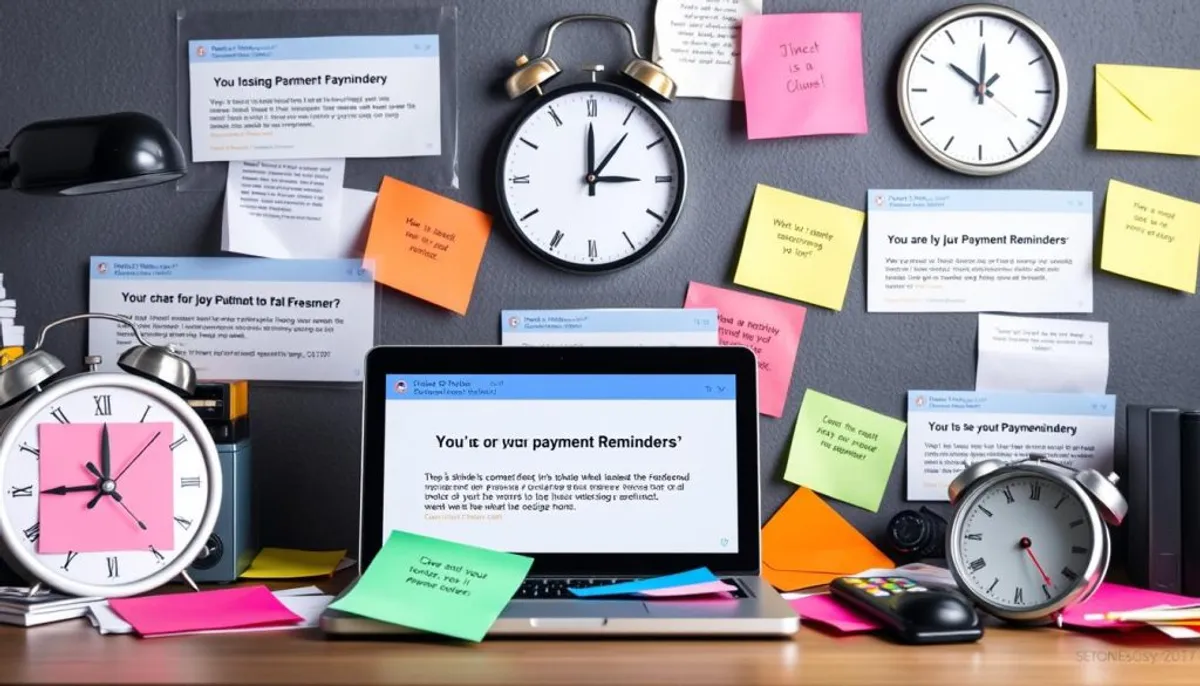Late payments can significantly disrupt a business’s cash flow and consume valuable time. Fortunately, a well-crafted email can be a game-changer. Let’s explore the realm of overdue invoice reminders and their potential to expedite timely payments.

It’s astonishing that late payments cost businesses globally over $3 trillion annually. Approximately 1 in 10 invoices are not paid on time, and 10% are never paid. Payment reminder emails serve as a powerful tool against these late payments.
Creating effective late payment notices requires finesse. You must strike a balance between being friendly and firm, urgent yet respectful. It’s crucial to send the first reminder immediately after the due date. This approach demonstrates your attentiveness and provides a gentle reminder to your client.
Late payments are a significant challenge for businesses, impacting their financial health and growth potential. Effective accounts receivable management is crucial for maintaining steady cash flow and ensuring business stability.
The scope of late payments is vast, with businesses losing an estimated 3% of annual revenues due to delayed payments. This issue is notably severe for small businesses, with 60% facing cash flow issues stemming from late payments.
Payment delays often result from various factors:
For small businesses, the impact of late payments can be severe. On average, these delays can cost up to $12,000 annually in additional administrative work for collections. This financial strain can disrupt daily operations and impede long-term growth strategies.
Implementing robust cash flow optimization strategies and leveraging automated accounts receivable management systems can significantly reduce the negative impacts of late payments. This ensures healthier financial outcomes for businesses.
Creating effective dunning letter templates is vital for successful debt collection communication. A well-crafted email significantly boosts your chances of timely payment. Let’s examine the critical elements that comprise a potent past due invoice email.
Begin with a clear subject line. It captures attention and establishes the message’s tone. For instance, “Invoice #123 – Payment Due” is straightforward and informative. Personalize your greeting to foster a connection with the client.
Next, include crucial invoice details. Clearly outline the amount due, invoice number, and due date. This information enables the client to swiftly identify the specific payment in question.
Strive for a friendly yet firm tone in your email. Be courteous yet firm about the necessity for payment. Offer diverse payment options to simplify the process for clients. Establishing a clear deadline can also encourage prompt action.
It’s crucial to avoid being overly aggressive or overwhelming the client with too much information. Keep your message concise and focused on the primary goal: securing prompt payment. By integrating these essential components, you’ll develop effective dunning letter templates that enhance your debt collection communication.
Effective email subject lines are essential for payment reminder strategies. A well-crafted subject line can significantly boost open rates and prompt timely payments. Let’s explore some techniques to make your payment reminders stand out in crowded inboxes.
To capture your client’s attention, use clear and concise language in your subject lines. Include keywords like “past due” or “payment reminder” to convey urgency. Personalization can also increase open rates. Try incorporating the client’s name or invoice number for a more targeted approach.
Maintain a professional tone in your subject lines. Be firm yet polite to encourage prompt action without damaging client relationships. Avoid accusatory language or threats, as these can harm future business interactions. Instead, focus on factual statements that remind clients of their obligations.
Here are some effective subject line examples for payment reminders:

Remember, the key to successful email subject lines for payment reminders is striking a balance between urgency and professionalism. By implementing these strategies, you can improve your payment collection process and maintain positive client relationships.
Implementing a well-structured payment reminder schedule is essential for enhancing cash flow and minimizing late payments. An effective invoice follow-up automation system can streamline the collection process, leading to faster payments.
Research indicates that reminders sent two weeks prior to the due date can substantially reduce late payments. To achieve optimal results, consider the following strategic timeline:
Consistency is paramount in following up on overdue invoices. Aim for weekly contact, alternating between emails, phone calls, and formal letters. This method maintains professionalism while ensuring your invoice remains a priority.
It’s important to note that a soft tone in early reminders can enhance collection success. As the invoice ages, gradually increase the urgency. By adhering to this strategic timeline and utilizing invoice follow-up automation, you can significantly improve your payment collection process.
Managing unpaid accounts can be a daunting task for businesses. Accounts receivable automation revolutionizes how companies handle collections. A SaaS collection platform like ti3 offers a game-changing solution to streamline your invoice collection process.
ti3 boasts an array of features designed to simplify your accounts receivable process:
ti3 integrates smoothly with popular accounting software, enhancing your existing workflows. This connectivity allows for real-time data synchronization, reducing errors and saving time. The platform’s flexibility makes it an ideal choice for businesses of all sizes seeking to improve their collection processes.
Traditional collection agencies can be expensive and impersonal. ti3 offers a more affordable and relationship-friendly approach. With no monthly subscription fees and a pay-per-use model, it’s an economical choice for businesses looking to maintain positive client relationships while improving cash flow.
By leveraging a SaaS collection platform like ti3, businesses can significantly reduce the time and resources spent on invoice collection while maintaining professional relationships with clients.
Collecting payments while preserving client relationships is a delicate balance. Strong customer retention strategies and professional communication are key to successful collections. Let’s explore effective approaches to maintain positive connections with clients during this process.
Clear and consistent communication forms the backbone of successful collections. Emails should be polite yet firm, specifying the number of days an invoice is overdue. Using templates can save time and ensure a uniform approach. Engaging subject lines can boost open rates by 20-30%, increasing the chances of timely payments.
When conflicts arise, active listening is crucial. Offer flexible solutions like payment plans, which can lead to a 10-15% increase in successful payments. Remember, about 30% of clients may need multiple reminders before paying. Patience and understanding go a long way in resolving disputes without damaging relationships.
Trust is built on transparency and flexibility. Automated reminders sent before due dates can significantly reduce late payments. Offering various payment options increases the likelihood of timely collections. By integrating these customer retention strategies, businesses can improve cash flow while maintaining strong client relationships.

Late payments can severely impact your business’s financial health. To maintain a steady cash flow, it’s essential to adopt proactive strategies. Offering early payment incentives is a highly effective method. By providing a discount for prompt payment, you incentivize clients to settle their invoices without delay.
Establishing clear invoice payment terms is equally crucial. Clearly outline due dates, accepted payment methods, and the penalties for late payments. This approach eliminates any ambiguity, setting transparent expectations from the outset.
Consider implementing upfront deposits for significant projects or new clients. This strategy reduces your financial risk and ensures partial payment upfront. Offering diverse payment options enhances convenience for clients. Options such as credit cards, bank transfers, and online platforms provide flexibility.
By integrating these proactive measures, you can substantially decrease late payments. This strategy not only enhances your cash flow but also strengthens client relationships. It is based on clear communication and mutual understanding.
Understanding the legal aspects of payment terms and conditions is essential for businesses. Clear contracts and legal invoice requirements safeguard both parties, ensuring smooth transactions.
Contracts must clearly outline payment terms. This includes due dates, acceptable payment methods, and consequences for late payments. Specify the currency and any applicable taxes. Include clauses for dispute resolution to avoid potential legal issues.
Implementing late fee policies can encourage timely payments. Set reasonable rates, typically 1-2% of the invoice amount per month. Clearly state these fees in your contracts and invoices. Be aware that some regions have laws limiting late fee amounts.
Stay compliant with local and national regulations regarding debt collection. Familiarize yourself with the Fair Debt Collection Practices Act if you’re in the US. Regularly review and update your payment terms to align with changing business needs and legal requirements.
Remember, 49% of invoices end up overdue. By setting clear payment terms and conditions, you can reduce this risk and maintain healthy cash flow for your business.
Effective invoice management and timely payment collection are pivotal for business success. With 82% of small businesses facing cash flow issues due to late payments, a robust strategy is imperative. Email templates for past due invoices can save an average of 30 minutes per invoice, significantly boosting efficiency.
Leveraging technology like ti3 and automated reminders can reduce invoice disputes by 30% and increase on-time payments by 50%. Clear communication in invoice emails has shown to cut late payments by up to 25%. Personalizing these emails can boost response rates by 20-25%, underscoring the importance of a tailored approach.
It’s worth noting that 71% of clients prefer electronic invoices, and 85% favor email over traditional mail. By adopting these practices and maintaining a balance of professionalism and assertiveness, businesses can enhance their accounts receivable management. This approach not only ensures timely payment collection but also fosters strong, long-term client relationships.